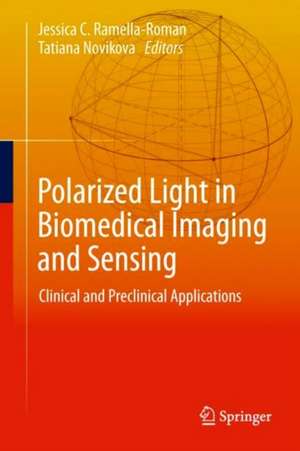Polarized Light in Biomedical Imaging and Sensing: Clinical and Preclinical Applications
Editat de Jessica C. Ramella-Roman, Tatiana Novikovaen Limba Engleză Hardback – 15 noi 2022
- Emphasizes biomedical imaging and sensing;
- Describes new computational approaches with examples;
- Provides detailed descriptions of novel instrumentation.
| Toate formatele și edițiile | Preț | Express |
|---|---|---|
| Paperback (1) | 987.74 lei 38-44 zile | |
| Springer International Publishing – 15 noi 2023 | 987.74 lei 38-44 zile | |
| Hardback (1) | 1170.68 lei 3-5 săpt. | |
| Springer International Publishing – 15 noi 2022 | 1170.68 lei 3-5 săpt. |
Preț: 1170.68 lei
Preț vechi: 1232.29 lei
-5% Nou
Puncte Express: 1756
Preț estimativ în valută:
224.01€ • 234.48$ • 186.45£
224.01€ • 234.48$ • 186.45£
Carte disponibilă
Livrare economică 10-24 martie
Preluare comenzi: 021 569.72.76
Specificații
ISBN-13: 9783031047404
ISBN-10: 3031047400
Pagini: 362
Ilustrații: VI, 362 p. 130 illus., 111 illus. in color.
Dimensiuni: 155 x 235 mm
Greutate: 0.75 kg
Ediția:1st ed. 2023
Editura: Springer International Publishing
Colecția Springer
Locul publicării:Cham, Switzerland
ISBN-10: 3031047400
Pagini: 362
Ilustrații: VI, 362 p. 130 illus., 111 illus. in color.
Dimensiuni: 155 x 235 mm
Greutate: 0.75 kg
Ediția:1st ed. 2023
Editura: Springer International Publishing
Colecția Springer
Locul publicării:Cham, Switzerland
Cuprins
Introduction to the physics of polarized light.- History of the application of polarized light.- Mueller Matrix instrumentation design for clinical applications.- Clinical applications of PS-OCT.- Mueller matrix analysis, decompositions and novel quantitative approaches to data analysis.- Single Scattering applications.- Polarized light Monte Carlo modeling.- Cancer staging with polarized light.- Polarized light and the skin.- Polarized light and the eye.- Polarized light and the brain.- Polarized light endoscopy.- Polarized light (Mueller Matrix) microscopy.- Confocal Mueller Matrix microscopy and hybrid systems.- Conclusions.
Notă biografică
Jessica C. Ramella-Roman received an Electrical Engineering degree (Laurea) from the University of Pavia, Italy in 1993, and a Master's and Ph.D. in Electrical Engineering from Oregon Health Science University in 2004. She was a Post-Doctoral Fellow at the Applied Physics Laboratory of the Johns Hopkins University from 2004 to 2005. She was then an Assistant Professor at The Catholic University of America from 2005 to 2010 and an Associate Professor from 2010 to 2013. She was Research Assistant Professor in the School of Medicine at Johns Hopkins University from 2010-2020. Since 2013, she is an Associate Professor at Florida International University (FIU) in the Biomedical Engineering Department and an Associate Research Professor in the Department of Ophthalmology at the Herbert Wertheim College of Medicine at FIU. Dr Ramella-Roman is a Senior Member of Optica (formerly OSA) and a Fellow of SPIE. Her research focuses on the use of polarization and spectroscopy for multiple biomedical applications including the determination of order and alignment in anisotropic and birefringent tissues, the study of polarized transport in heterogeneous environments through polarization-sensitive Monte Carlo modelling, and the validation and extension of Mueller polarimetry to multimodal applications of nonlinear microscopy.
Tatiana Novikova received her M.S. degree (Cum Laude) in Applied Mathematics from the Moscow State University, Russia, a Ph.D. in Applied Physics and Mathematics from the Moscow Institute of Mathematical Modelling, Russian Academy of Sciences and HDR (habilitation) in Physics from the University Paris XI, Orsay, France. Dr. Novikova leads the Characterization and Modeling Division of the Laboratory of Interfaces and Thin Films at Ecole Polytechnique, IP Paris, France. She is also a Courtesy Professor of the Biomedical Engineering Department at Florida International University, Miami, USA. Dr. Novikova is Fellow of Optica (formerly OSA),a member of SPIE and IEEE, and the recipient of SPIE 2020 G. G. Stokes Award in optical polarization. Her research interests and area of expertise include optical polarization, Mueller polarimetry, biomedical imaging, clinical applications of polarized light, optical metrology, and computational modelling of electromagnetic wave interaction with structured and random media.
Tatiana Novikova received her M.S. degree (Cum Laude) in Applied Mathematics from the Moscow State University, Russia, a Ph.D. in Applied Physics and Mathematics from the Moscow Institute of Mathematical Modelling, Russian Academy of Sciences and HDR (habilitation) in Physics from the University Paris XI, Orsay, France. Dr. Novikova leads the Characterization and Modeling Division of the Laboratory of Interfaces and Thin Films at Ecole Polytechnique, IP Paris, France. She is also a Courtesy Professor of the Biomedical Engineering Department at Florida International University, Miami, USA. Dr. Novikova is Fellow of Optica (formerly OSA),a member of SPIE and IEEE, and the recipient of SPIE 2020 G. G. Stokes Award in optical polarization. Her research interests and area of expertise include optical polarization, Mueller polarimetry, biomedical imaging, clinical applications of polarized light, optical metrology, and computational modelling of electromagnetic wave interaction with structured and random media.
Textul de pe ultima copertă
This book focuses on biomedical applications of polarized light, covering instrumentation and modeling specific to the field. This will be the first book, written by leading researchers in the field, to tackle this important topic. Readers will learn the fundamentals of polarized light transport and how to develop instrumentation for clinical and preclinical studies. They will also become familiar with the latest advancement in data analysis and image processing for a variety of medical applications. The book is dedicated specifically to the biomedical community, including scientists, engineers, and physicians working on the development of instrumentation for clinical and preclinical use.
- Emphasizes biomedical imaging and sensing;
- Describes new computational approaches with examples;
- Provides detailed descriptions of novel instrumentation.
Caracteristici
Emphasizes biomedical imaging and sensing Describes new computational approaches with examples Provides detailed descriptions of novel instrumentation
